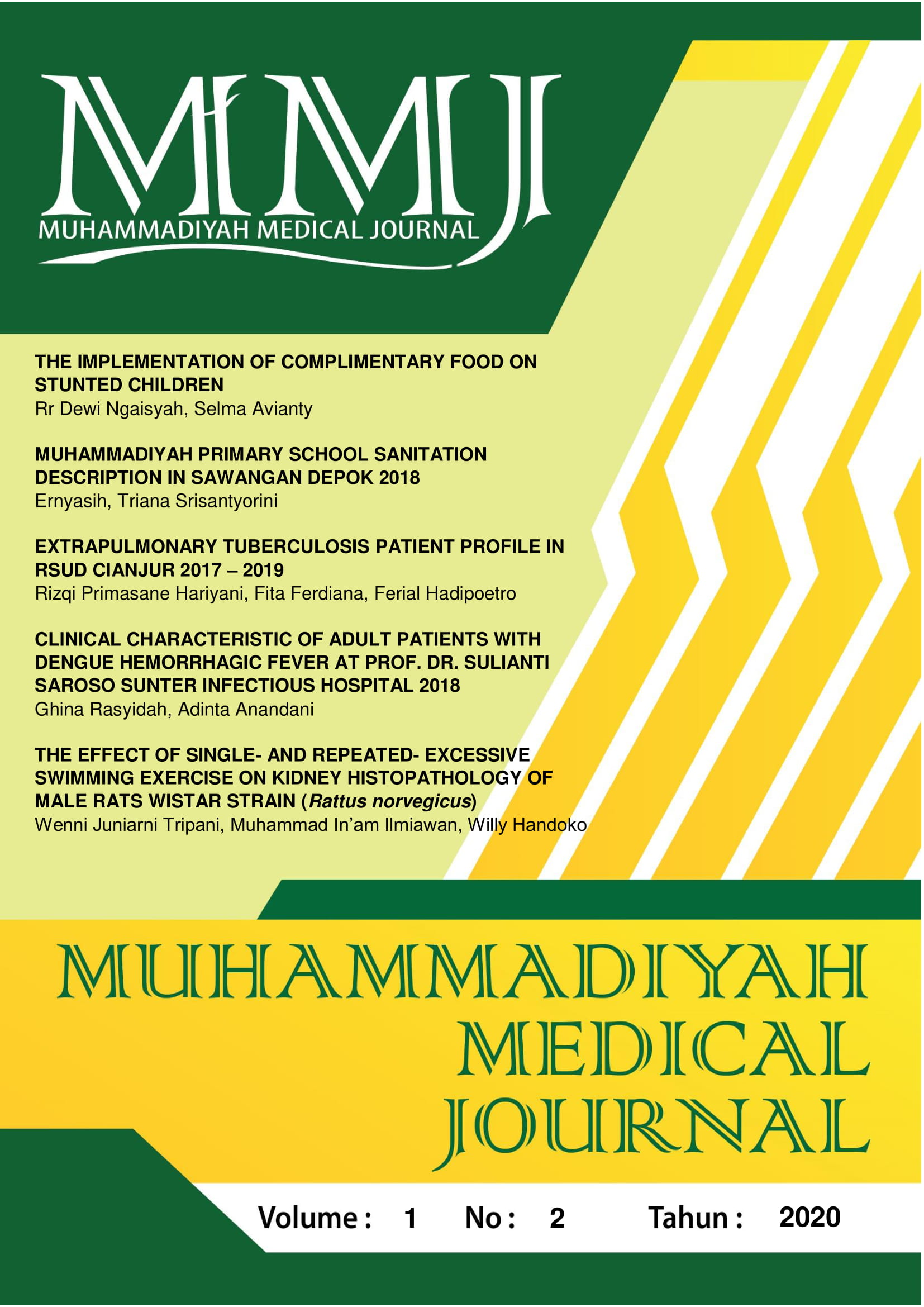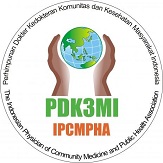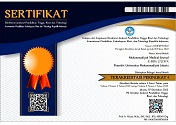Protective Effect of Combination Commercial Black Seed Oil (Nigella sativa) and Honey Against Cisplatin-Induced Hepatotoxicity in Rats
DOI:
https://doi.org/10.24853/mmj.1.2.43-48Keywords:
Black Seed Oil, Honey, Cisplatin, Malondialdehyde, Combination IndexAbstract
Background: The chemotherapeutic use of cisplatin (CP) is restricted because of its hepatotoxicity induced by oxidative stress. Malondialdehyde (MDA) is a secondary product of lipid peroxidation as a biomarker of oxidative stress. Individual administration of black seed oil (BSO) or honey (H) demonstrated hepatoprotective effect in rats. Interaction of both substances when administrated as combination can be evaluated using combination index (CI) to quantitatively depict synergism (CI<1), additive (CI=1) and antagonism effect (CI>1). Objective: to know the combination effect of BSO and honey on rat liver tissue given CP exposure. Methods: This study used 30 rats were divided into 10 groups. Normal group (N); Negative control group (NC); P1-P4 groups were administerated BSO (1 and 2 mL/kg) and honey (3.7 and 7.4 mL/kg); P5-P8 groups were combination of BSO and H. P1-P8 groups were given BSO and honey orally for 21 days. On the 18th day, NC and P1-P8 groups were given CP 8 mg/kg intraperitoneally, while the N group was given NaCl 0.9% 1 mL/kg intraperitoneally. Result: Malondialdehyde (MDA) levels were found to be lower in P1-P8 groups compared to negative control group and P6 and P7 groups have levels equivalent to MDA levels of normal control group (p > 0.05). Conclusion: Combination of BSO and honey provides a protective effect on cisplatin-induced rat liver tissue damage indicated by reduced MDA levels, but all combination group showed antagonism effect.References
Gold JM RA. Cisplatin (Cisplatinum). Treasure Island (FL): StatPearls; 2019.
Bano N, Najam R. Histopathological and biochemical assessment of liver damage in albino Wistar rats treated with cytotoxic platinum compounds in combination with 5-fluorouracil. Arch Med Sci. 2019;15(4):1092–103.
Poluektova LY, Arnold LL, Kabanov A V, Cohen SM, Bronich TK. Cisplatin-loaded core cross-linked micelles : comparative pharmacokinetics, antitumor activity, and toxicity in mice. Intern J Nanomed. 2012;7:2557–71.
Desai SD, Saheb SH, Das KK, Haseena S. Effect of Thymoquinone on MDA and SOD levels in Sterptozotocine Induced Diabetic Albino Rats . J Pharm Sci Res. 2015;7(8):523–6.
Ayala A, Muñoz MF, Argüelles S. Lipid peroxidation: Production, metabolism, and signaling mechanisms of malondialdehyde and 4-hydroxy-2-nonenal. Oxid Med Cell Longev. 2014;2014:1–31.
Forouzanfar F, Fazly Bazzaz BS, Hosseinzadeh H. Black cumin (Nigella sativa) and its constituent (thymoquinone): A review on antimicrobial effects. Iran J Basic Med Sci. 2014;17(12):929–38.
Miguel MG, Antunes MD, Faleiro ML. Honey as a complementary medicine. Integr Med Insights. 2017;12:1–15.
Abdallah MA, Zayed MA, Kelany ME. Antioxidant and antiapoptic effects of combined sidr honey and nigella sativa oil against paracetamol-induced hepato- nephrotoxicity in rats. ZUMJ. 2016;22(1):1–12.
Alkadri SLF, Ilmiawan MI, Handini M. Efek Protektif Kombinasi Minyak Jintan Hitam dan Madu terhadap Hepatotoksisitas pada Tikus Akibat Sisplatin (The Protective Effects of The Combination of Black Cumin Oil and Honey against Hepatotoxicity in Rats Due Sisplatin). eJKI. 2019;7(2):101–8.
Wills ED. Mechanisms of Lipid Peroxide Formation in Animal Tissues. Biochem J. 1966;99:667–76.
Chou TC. Drug combination studies and their synergy quantification using the chou-talalay method. Cancer Res. 2010;70(2):440–6.
Ansarin K, Khoubnasabjafari M, Jouyban A. Reliability of malondialdehyde as a biomarker of oxidative stress in psychological disorders. BioImpacts. 2015;5(3):123–7.
Palipoch S, Punsawad C, Koomhin P, Suwannalert P. Hepatoprotective effect of curcumin and alpha-tocopherol against cisplatin-induced oxidative stress. BMC Complement Altern Med. 2014;14(1):1–8.
Üstün R, Kaval E, Korkaya H. Thymoquinone prevents cisplatin neurotoxicity in primary DRG neurons. 2018;69:68–76.
Mahmoud YK, Abdelrazek HMA. Biomedicine & Pharmacotherapy Cancer : Thymoquinone antioxidant / pro-oxidant e ff ect as potential anticancer remedy. 2019;115(2019):1–14.
Sheikhbahaei F, Khazaei M, Rabzia A, Mansouri K, Ghanbari A. Protective Effects of Thymoquinone against Methotrexate-Induced Germ Cell Apoptosis in Male Mice. Int J Fertil Steril. 2016;9(4):541–7.
Farooqui Z, Ahmed F, Rizwan S, Shahid F, Khan A, Khan F. Protective effect of Nigella sativa oil on cisplatin induced nephrotoxicity and oxidative damage in rat kidney. Biomed Pharmacother. 2017;85:7–15.
Neamatallah TA, Nagla AE, Aymn TA, Soad SA BG. Honey protects against cisplatin-induced hepatic and renal toxicity through inhibition of NF-kB-mediated COX-2 expression and oxidative stress dependent BAX/Bcl-2/caspase-3 apoptotic pathway. Food Funct. 2018;1–33.
Bela Risqiyani Fajrilah. Pengaruh Pemberian Madu Terhadap Kadar Malondialdehyde (MDA) Plasma Darah pada Tikus Putih Galur Wistar yang Diinduksi Alloxan (The Effect of Honey on The Levels of Malondialdehyde (MDA) Blood Plasma in White Rats Strain Wistar Induced Alloxan). Sains Med. 2013;5(2):98–100.
Al-Farsi M, Al-Amri A, Al-Hadhrami A, Al-Belushi S. Color, flavonoids, phenolics and antioxidant of Omani honey. Heliyon. 2018;4.
Cianciosi D, Hernandes TYF, Afrin S, Gasparrini M, Rodriguez PR, Manna PP, et al. Phenolic compounds in honey and their associated health benefits: A review. Molecules. 2018;23:1–20.
Mohamad S, Ibrahim N, Yusof H. Blood Pressure and Lipid Lowering Effects of Nigella sativa Seeds and Honey Mixture. IOSR J Nurs Heal Sci. 2014;3(5):89–96.
Gupta VK, Sharma SK. Plants as natural antioxidants. Nat Prod Radiance. 2006;5(4):326–34.
Downloads
Published
Issue
Section
License
Authors who publish in the Muhammadiyah Medical Journal agree to the following terms:
- Authors retain copyright and grant Muhammadiyah Medical Journal right of first publication with the work simultaneously licensed under a Creative Commons Attribution Licence that allows others to adapt (remix, transform, and build) upon the work non-commercially with an acknowledgement of the work's authorship and initial publication in Muhammadiyah Medical Journal.
- Authors are permitted to share (copy and redistribute) the journal's published version of the work non-commercially (e.g., post it to an institutional repository or publish it in a book), with an acknowledgement of its initial publication in Muhammadiyah Medical Journal.








